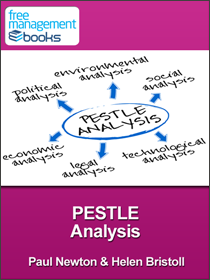PESTLE Analysis - Free eBook in PDF Format
 |
 |
|
Book Description - ISBN 978-1-62620-998-5 (26 Pages)
The PESTLE Analysis is a useful method to use in order to identify the external factors that influence an organization. This free eBook explains how to carry out a PESTLE Analysis.
Chapter 1 - What is a PESTLE Analysis?
A PESTLE Analysis can be used to consider political, economic, social, technological, legal, and environmental issues that may affect your organization. It is often used when launching a new product or service, exploring a new route to market, or selling into a new country or region.
Chapter 2 - What are the PESTLE Factors?
There are six factors that form the framework of the PESTLE analysis which can be used to help you consider Political, Economic, Social, Technological, Legal, and Environmental issues.
Chapter 3 - What are the Political Factors of a PESTLE Analysis?
Political factors include government attitudes to employment, consumer protection, the environment, taxation, trade restrictions, and societal reforms, as well as the burden of bureaucracy and the level of corruption.
Chapter 4 - What are the Economic Factors of a PESTLE Analysis?
Economic factors include assessing potential changes to an economy's inflation rate, taxes, interest rates, exchange rates, trading regulations, and excise duties.
Chapter 5 - What are the Social Factors of a PESTLE Analysis?
Social factors include age distribution, population growth rate, employment levels, income statistics, education and career trends, and religious beliefs, as well as cultural and social conventions.
Chapter 6 - What are the Technological Factors of a PESTLE Analysis?
Technological factors can be broadly divided into two areas: manufacture and infrastructure. By exploiting opportunities to update or alter their production an organization can gain market share, thereby attaining a strong competitive advantage.
Chapter 7 - Chapter 1 - What are the Legal Factors of a PESTLE Analysis?
Legal factors include current and impending legislation that may affect the industry in areas such as employment, competition, and health and safety.
Chapter 8 - What are the Environmental Factors of a PESTLE Analysis?
Environmental factors include infrastructure, cyclical weather, disposal of materials, energy availability and cost, and the ecological consequences of production processes.
Chapter 9 - What are the advantages and disadvantages of a PESTLE Analysis?
To maximize the benefit of the PESTLE Analysis it should be used on a regular basis within an organization to enable the identification of any trends. As with all techniques there are advantages and disadvantages to using it to help plan organizational strategy.
| You will learn: |
|
![]()
![]()
I Picked Up Many New Ideas and Ways of Thinking
To be completely honest, I had absolutely no idea what PESTLE analysis was before I read this eBook. The term sounded vaguely familiar, but I could place it in any of my past business experience or education. Perhaps I learned about it once upon a time and have since forgotten - sad to say I just can't remember. Nevertheless, I decided to read this book and pick up on what the concepts were and if they could help me in my daily work.
Quickly I learned that PESTLE analysis has to do with identifying the external factors that can influence the success or failure of your organization. I love working on forecasting and predicting, so I was already interested in reading the rest of the book and learning more. PESTLE (you probably already know) stands for Political, Economic, Social, Technological, Legal, and Environmental. Those six terms are all broad in scope and can mean a variety of different things, so I was interested to see how they are defined in the terms of this analysis method.
After providing an overview of the PESTLE method and some of the ways it is put into use, the book goes into each of the six points and offers examples of the kinds of external influences that could fall into each category. These examples were perhaps the most useful portion of the book for me, in that I was able to start to gain a clearer picture of how I could use the analysis within my own organization. Certainly some of the areas are more important to me specifically than others, but all six play some role in decisions that I am forced to make.
I specifically enjoyed the section on 'Technological Factors' and how they can play a role in shaping the decisions you make. Obviously, technology is at the forefront of just about everything in today's world, so it was interesting to read and thing about trying to plan ahead when it comes to tech. I think it is impossible to predict what technologies will be available and affordable in the future, but it is possible to think about how a specific organization or business could be affected by the possible developments. I can imagine long meetings being held trying to forecast where technology is headed and what it could mean for our organization.
Environmental factors is another section that seems particularly current and relevant. It seems that all kinds of businesses are now being touched by tighter regulations meant to protect the environment. Beyond just regulation, also thinking about the local weather and being too vulnerable to one natural disaster wiping out an entire organization is something very much worth considering. Diversity in business is always a good thing from an economic standpoint, but it might be just as valuable from a physical standpoint so as to not be overexposed to one single 'act of God'.
I'm happy I took the time to read this book on PESTLE analysis. After reading it, I realized that I already use many of the techniques and analysis methods in the book, I just never know it had a name. Despite that, I did pick up many new ideas and ways of thinking that I will be sure to incorporate in my daily managerial activities. I don't hesitate in recommending that you read this short eBook and brush up on all the points involved with PESTLE analysis.
Bill Baldwin
Highly Recommended
I was unfamiliar with the PESTLE analysis tool and needed to learn it quickly before a meeting next week. I was hoping to gain enough knowledge that I would be able to seem informed during the meeting. This book helped me understand what the PESTLE analysis tool is and what it is used for. This book helps break down the PESTLE analysis to help you better understand the external factors that impact your company. P-political, E-economical, S-social, T-technological, L-legal, E-environmental.
Those six topics can help you better understand issues that your company may be facing. You should not spend time figuring out which category to put an issue into, it only matters that you recognize that it could be an issue for you. The PESTLE analysis is used to find problems that are outside the control of your business and could impact it. The book outlines the five steps to process of the PESTLE analysis, which are: brainstorm and list key issues that are outside the organization's control, broadly identify the implications of each issue, rate its relative importance to the organization (e.g. critical, extensive, important, significant, moderate, or insignificant), rate the likelihood of it occurring (e.g. certainty, extremely likely, likely, potential, remote possibility, or will not transpire), briefly consider the implications if the issue did occur. Notice that you are no supposed to find solutions to any of the issues. This is merely to find any issue that may occur and how likely it is that they will occur.
The book then takes a deeper looking into each of the categories starting with Political. Political can be a tough category because it is always changing. Anytime the government or leadership changes it can cause changes to laws, rules, and regulations. This book gives great examples as to what to look for in the political category. Economical is concerned with interest rates, taxes, inflation, and other things that are financial based.
Social factors are lifestyle, culture, religion, and education. Technological seems to be pretty self-explanatory, technology based factors. I was surprised to see just how much was covered in the technology category. It was a lot more than staying up to date on the latest software, as I had previously thought. Legal factors can also be difficult since laws are constantly changing. Environmental covers infrastructures and contamination to name a few. What I liked about this book was that at the beginning of each section describing each category it listed several factors that could be an issue for the category. I thought that the pictures used were extremely helpful.
The book finishes by listing the advantages and the disadvantages of using the PESTLE analysis tool. I really liked that it showed both sides of this tool and not just the positive side. This book was extremely useful. If you have never even heard of the PESTLE analysis tool, after reading this book you will fully understand it. This book did a great job of describing each of the categories in depth and gives great examples for everyone to take back and used for each category. I highly recommend this book. Not only was it short and used in a context that is easily understood, but it also is FREE.
Derrick Schultz
Using the SWOT Analysis - As a manager, your role in any strategic planning is likely to involve providing operational data to help assess the internal capabilities, and (depending on your job function) you may also be asked to provide market intelligence. The completion of a SWOT analysis should help you to decide which market segments offer you the best opportunities for success and profitable growth over the life cycle of your product or service.
Using the Boston Matrix - The Boston Matrix was developed to help organizations allocate their investments across its product range and divisions. However, it is sometimes used as part of brand level decision-making - something it was never designed for. Many of the misconceptions associated with the Boston matrix come from the nature of the economic climate that existed at the time of its inception. These fundamental assumptions were incorporated into its design and are not always applicable in today's global fast-paced market.


